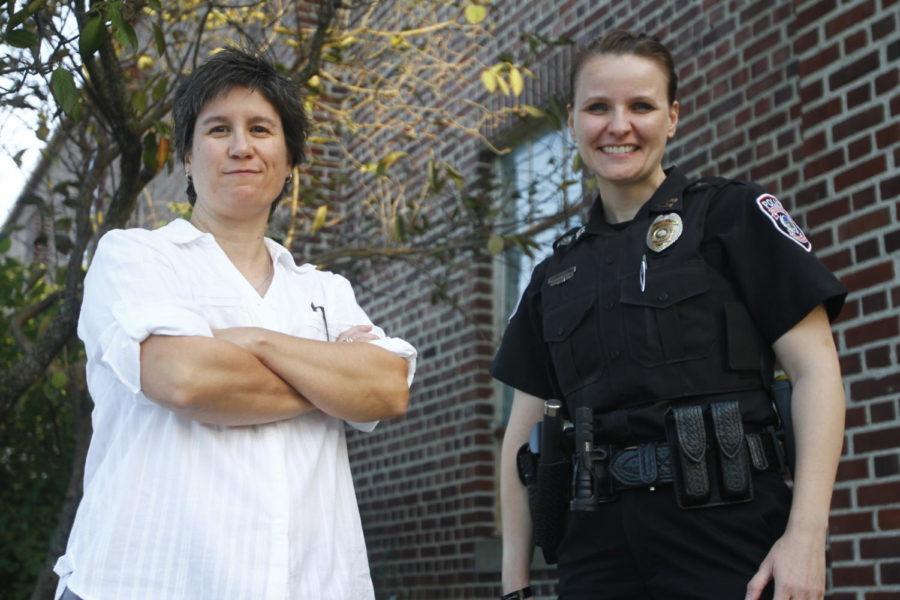ISU Police, ROTC help professor research suspicious behavior detection
Brian Achenbach/Iowa State Daily
Dawn Sweet and Lt. Carrie Jacobs have worked together on a case study that involves behavior and threat assessment. Jacobs’ involvement in the research opens doors for Sweet in terms of information and resources.
October 3, 2013
Dawn Sweet wants to prevent future Boston Marathon bombings.
The adjunct assistant professor of psychology has been performing research on suspicious behavior in crowds as part of her research about nonverbal cues.
Her research, she hopes, will help ensure public safety at events, such as when President Barack Obama came to visit Iowa State in August 2012.
“When we look at places like what’s going on in Afghanistan and Iraq with roadside bombings, the system currently in place relies on technology,” Sweet said. “When an IED, [ an improvised explosive device,] is implanted, bomb sniffers, robots go and find it.
“But if we can identify who the person is with the IED tucked in the backpack or wearing the suicide vest, then we can prevent some of the IEDs from being implanted.”
Sweet said her research is about what can be done to train law enforcement officers and military personnel to be better equipped to ensure the public’s safety and their own safety.
Sweet’s research has been a collaboration with the ISU Police Department and the ISU Army ROTC.
During her research, Sweet used Army ROTC cadets. The cadets were separated into pairs, one person carrying a bucket of water in a backpack and the other partner not.
The bucket of water was used to represent a payload.
The cadets were video recorded as they walked across campus concealing the bucket of water.
Their goals to carry the bucket of water without being identified as the threat.
Sweet wanted the cadets to come up with a plan that would help them not be identified as the person with the payload.
“My goal was to walk smoothly to prevent any signs from the backpack, as well as to walk casually and be conscious as to what I was doing,” said Raymond Kiemen, Army ROTC cadet and senior in interdisciplinary studies.
Isabella Hamby, senior in psychology, was one of the 18 cadets who participated in this study.
“It really made us aware of our actions and how we move when we walk around strangers in a crowd and what we should be looking for when people are acting suspicious,” Hamby said.
ISU Police asked other law enforcement officials across Iowa to participate in the study.
Of the 55 officers from the five different departments, Sweet’s research showed that 50 percent of them picked the right cadet.
Predictors that helped the officers spot the target cadet included stiff posture, an unnatural stride in walk and touching of the backpack.
Sweet found that officers with less than 16 years of experience outperformed officers with 16 to 40 years of experience. Female and male officers with one to six years of experience were 55 and 50 percent accurate.
Female and male officers with 16 to 40 years of experience were 48 and 45 percent accurate on determining the person with the payload.
Sweet stated that because these officers have more experience, they tend to rely on past experiences to inform the decisions about the immediate time.
She also said this maybe due to confirmation bias.
“Confirmation bias occurs when we search for evidence or interpret evidence in a way that supports our beliefs,” Sweet said. “An officer with more experience has certainly spent more time identifying a potential threat, but there may be a big difference between what behaviors they think are associated with suspicious behavior and which behaviors actually are.”
Kent Kroeger, coordinator for statistical consulting, helped Sweet collect data for this research.
“This is the first step in a much longer process of doing research,” Kroeger said, “We wanted to put together a simple design that will use as an insight on a much larger design.”
For a long-term plan, Kroeger hopes to involve more real world scenarios that can be used for training.
“Ultimately, our research shows just how difficult it is to identify suspicious behavior and that researchers need to continue working with law enforcement officers to truly understand which behaviors are associated with suspicious behavior,” Sweet said.







